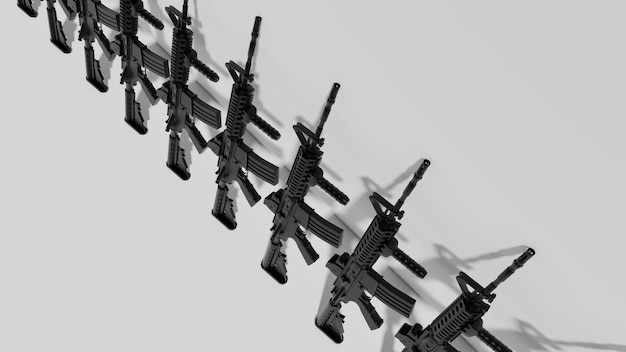Understanding Gun Control Debate: Proposed Solutions in the US

Understanding the current debate over gun control legislation involves navigating complex proposed solutions, ranging from universal background checks and assault weapons bans to mental health reforms and red flag laws, each with varying degrees of support and potential impact on public safety in the US.
The debate around gun control legislation in the United States is one of the most contentious and highly politicized issues today. Understanding the current debate over gun control legislation: What are the proposed solutions? requires a close examination of the various perspectives, arguments, and potential policy changes being discussed.
The Landscape of Gun Violence in the US
Gun violence is a major public health issue in the United States, with significant consequences for individuals, families, and communities. It is vital to understanding the scale and scope of the problem before diving into proposed solutions.
Understanding the statistics and impact of gun violence helps frame the urgency and necessity of the gun control debate. Here’s a look at the numbers:
Statistics on Gun Violence
Each year, thousands of Americans are killed or injured by firearms. Understanding these statistics provides a baseline for evaluating the effectiveness of proposed solutions. Key data points include:
- Gun Deaths: Over 40,000 people die from gun-related injuries annually in the U.S., including homicides and suicides.
- Mass Shootings: The U.S. experiences more mass shootings than any other developed country.
- Injuries: Tens of thousands more are injured by firearms, often resulting in lifelong disabilities.
Impact on Communities
Gun violence disproportionately affects certain communities and populations, leading to long-term social and economic consequences. Consider these impacts:
The effects of gun violence extend beyond the immediate victims, impacting mental health, economic stability, and social cohesion. The debate over gun control legislation seeks to address these extensive repercussions.

In conclusion, understanding the landscape of gun violence is crucial for evaluating the proposed solutions and their potential to reduce harm and improve public safety.
Universal Background Checks: A Key Proposal
One of the most widely discussed and supported proposals to reduce gun violence is universal background checks. This approach aims to ensure that all gun sales, including those between private citizens, require a background check through the National Instant Criminal Background Check System (NICS).
This proposal seeks to close loopholes and prevent firearms from falling into the hands of individuals legally prohibited from owning them. Let’s explore key aspects:
The Current System
Currently, federal law requires licensed gun dealers to conduct background checks on purchasers through NICS. However, many states have loopholes that allow private sales without background checks, opening the door for prohibited individuals to acquire guns.
Closing this “private sale loophole” is a central goal of universal background check proposals.
Proposed Changes
Universal background check legislation would require all gun sales, including those between private citizens, to go through a licensed dealer or designated agency that can conduct a background check. This would ensure that records are kept and that prohibited individuals are identified.
- Closing Loopholes: Requires background checks for all gun sales, including those at gun shows and online.
- Enforcement: Stronger penalties for illegal gun sales and straw purchasing.
- Record Keeping: Better tracking of gun sales to prevent illegal firearms trafficking.
The impact of universal background checks could be significant in preventing gun violence by making it more difficult for prohibited individuals to acquire firearms.
To conclude, universal background checks represent a key proposal aimed at closing loopholes in the current system and preventing prohibited individuals from acquiring firearms, potentially reducing gun violence.
Assault Weapons Bans: Restrictions and Debates
Assault weapons bans are another contentious issue in the gun control debate. These bans seek to prohibit the sale, transfer, and possession of certain types of firearms deemed to be particularly dangerous due to their military-style features.
The debate on assault weapons bans involves complex legal and practical considerations. Here’s a breakdown:
Defining “Assault Weapons”
The term “assault weapon” is often used to describe semi-automatic rifles with military-style features, such as detachable magazines, pistol grips, and flash suppressors. However, the legal definition can vary, leading to confusion and controversy.
Determining which firearms qualify as “assault weapons” is a critical aspect of the debate.
Arguments For and Against Bans
Supporters of assault weapons bans argue that these firearms are disproportionately used in mass shootings and that their military-style features make them more lethal. Opponents argue that such bans infringe on Second Amendment rights and that the focus should be on enforcing existing laws and addressing underlying causes of violence.

In summary, the debate over assault weapons bans is complex, involving legal, practical, and constitutional considerations, with differing views on their effectiveness and impact on Second Amendment rights.
Red Flag Laws: Preventing Crisis Situations
Red flag laws, also known as Extreme Risk Protection Orders (ERPOs), are laws that allow law enforcement or family members to petition a court to temporarily remove firearms from individuals deemed to be a danger to themselves or others.
These laws aim to prevent gun violence by intervening in crisis situations. Let’s examine their mechanics and impact:
How Red Flag Laws Work
Red flag laws typically involve a two-step process: first, a petition is filed with the court based on credible evidence that an individual poses a risk; second, a hearing is held where the individual has the opportunity to present their case. If the court finds sufficient evidence, an ERPO is issued, and firearms are temporarily removed.
- Petition Process: Law enforcement or family members can petition the court.
- Due Process: Individuals have the right to a hearing and to present evidence.
- Temporary Removal: Firearms are temporarily removed to prevent potential violence.
Effectiveness and Concerns
Studies suggest that red flag laws can be effective in preventing suicides and mass shootings by temporarily removing firearms from individuals in crisis. However, concerns have been raised about potential due process violations and the risk of abuse.
In conclusion, red flag laws represent a targeted approach to preventing gun violence by temporarily removing firearms from individuals in crisis, balancing public safety concerns with due process rights.
Mental Health and Gun Violence: Addressing Root Causes
The relationship between mental health and gun violence is a complex and often misunderstood topic. While it’s important to avoid stigmatizing individuals with mental health conditions, addressing mental health is an essential part of a comprehensive approach to reducing gun violence.
The focus is on providing better access to mental health care and addressing underlying causes of violence. Consider these aspects:
The Role of Mental Health
Research indicates that the vast majority of individuals with mental health conditions are not violent. However, in some cases, mental health issues may contribute to an increased risk of violence, particularly when combined with other risk factors such as substance abuse and access to firearms.
Addressing mental health is about providing support and intervention to those who need it most.
Proposed Solutions
Proposed solutions include expanding access to mental health care, improving early intervention programs, and addressing the social and economic factors that contribute to mental health issues. These solutions aim to reduce violence by helping individuals address their underlying mental health needs.
To conclude, addressing mental health is a critical component of a comprehensive approach to reducing gun violence, focusing on early intervention, improved access to care, and addressing the root causes of mental health.
The Role of Community Violence Intervention Programs
Community Violence Intervention (CVI) programs are increasingly recognized as an effective approach to reducing gun violence by directly engaging with individuals and communities most affected by violence.
These programs focus on prevention, intervention, and support. Let’s explore their role:
What are CVI Programs?
CVI programs typically involve outreach workers, conflict mediation, and wraparound services to address the underlying causes of violence. These programs aim to reduce violence by building trust, providing resources, and promoting positive alternatives.
- Outreach Workers: Engaging with individuals at high risk of violence.
- Conflict Mediation: Resolving disputes before they escalate.
- Wraparound Services: Providing comprehensive support to address underlying needs.
Effectiveness and Impact
Studies have shown that CVI programs can be highly effective in reducing gun violence by interrupting cycles of violence and providing opportunities for positive change. These programs represent a promising approach to addressing gun violence at the community level.
In conclusion, CVI programs play a critical role in reducing gun violence by directly engaging with individuals and communities, providing resources, and promoting positive alternatives.
| Key Point | Brief Description |
|---|---|
| 🔑 Universal Background Checks | Require background checks for all gun sales to prevent prohibited individuals from acquiring firearms. |
| 🛡️ Assault Weapons Ban | Prohibits the sale and possession of certain military-style semi-automatic rifles. |
| 🚩 Red Flag Laws | Allow temporary removal of firearms from individuals deemed a danger to themselves or others. |
| 🧠 Mental Health Support | Expanding access to mental health care and addressing underlying mental health issues. |
Frequently Asked Questions
▼
The primary goal is to ensure that all gun sales, including those between private citizens, require a background check through the National Instant Criminal Background Check System (NICS), preventing prohibited individuals from acquiring firearms.
▼
Red flag laws allow law enforcement or family members to petition a court to temporarily remove firearms from individuals deemed to be a danger to themselves or others, based on credible evidence and due process.
▼
Opponents argue that such bans infringe on Second Amendment rights, and that the focus should be on enforcing existing laws and addressing underlying causes of violence, rather than restricting specific types of firearms.
▼
CVI programs reduce gun violence by engaging with individuals and communities most affected by violence, providing resources, conflict mediation, and wraparound services to address the underlying causes.
▼
While most individuals with mental health conditions are not violent, addressing mental health is essential as it can contribute to increased risk of violence in some cases, particularly when combined with other risk factors.
Conclusion
In conclusion, understanding the current debate over gun control legislation requires a comprehensive approach that addresses various factors contributing to gun violence. Proposed solutions such as universal background checks, assault weapons bans, red flag laws, mental health support, and community violence intervention programs each play a role in reducing gun violence and improving public safety.
